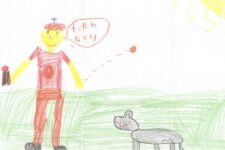
Children with cancer may benefit from having a cat or dog ‘pen pal’

A drawing by a child who took part in the animal pen pal scheme
Courtesy of YAPS and Anne Gillespie
Seriously ill children and teenagers appear to get emotional benefits from exchanging letters with cats and dogs affected by cancer.
The interspecies pen pal programme allows young people facing cancer and blood disorders to bond with animals going through similar challenges, whose owners write letters on their behalf.
“There is something just so unconditional about the love of an animal and the listening that an animal can provide,” says Anne Ingalls Gillespie at the University of Colorado, a former paediatric nurse. “They don’t argue, they don’t question; they just listen and validate.”
Animal-assisted interventions – in which patients spend time with trained dogs, cats and horses – have previously been found to offer emotional and mental health benefits for young cancer patients.
However, some cancer patients are so immunocompromised doctors forbid them from coming into contact with animals. Eager to find a solution for her young patients, Gillepsie designed a pen pal programme called Youth and Pet Survivors in which children and teenagers correspond with animals via letters.
The patients’ pen pals are animals going through similar treatments for life-threatening diseases, says Gillespie. She reached out to veterinary oncologists to find owners willing to take part, and then trained them to correspond with seriously ill children and teenagers in the voices of their pets.
To evaluate the effects of the programme, Gillespie and her colleagues collected 157 letters written by 16 young patients, with the consent of the patients, parents and pet owners. Exchanges lasted from four months to five years and included three to 39 letters per child. While most of the letters were hand-written and included colourful drawings as well as photos, some were typed and printed.
Most of the children’s letters addressed their illness and treatment, but the predominant theme was a growing relationship between the patient and the pet. “The children’s illness stories moved to the background as letters over time became more about their triumphs, hopes, dreams and what they did for fun,” says Gillespie.
An analysis of the letters revealed the correspondence enhanced the patients’ quality of life in ways similar to what has been seen with face-to-face animal therapy programmes, including improved mood, distraction from their problems and overall decreased emotional distress, Gillespie says.
That’s probably because the letters allowed the patients to express themselves freely and without judgement, and they offered a sense of unconditional acceptance, companionship and belonging, she says.
“If a child wrote, ‘I’m scared about my upcoming MRI scan’, or ‘I feel like the kids in my class don’t understand me’, the dog or cat could validate that,” Gillespie says. “They don’t offer advice. They just say, ‘Oh my gosh, I get it’.”
Pet owners also expressed increased well-being from taking part, saying the experience gave meaning to what they were going through, she adds. “They loved that their dog could make a difference in the life of a child, and it helped them process their emotions around their animal having cancer.” Some clearly stated the pets themselves benefited – although additional research would need to explore how or why.
Topics:



